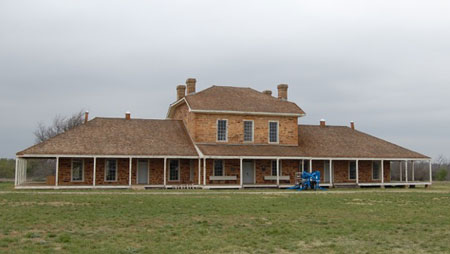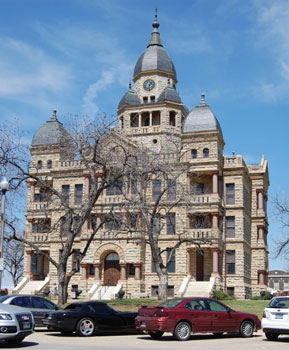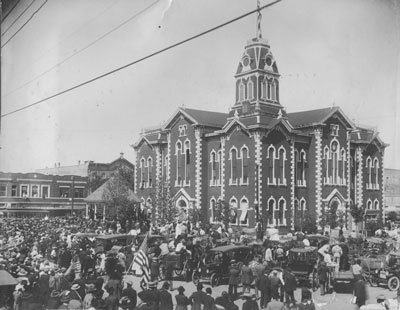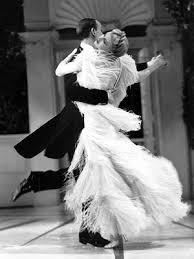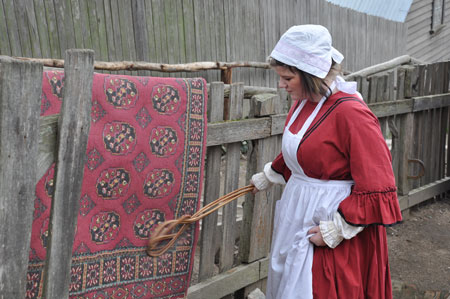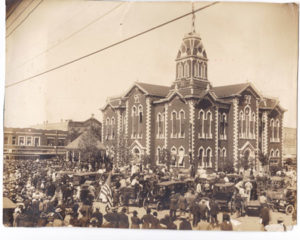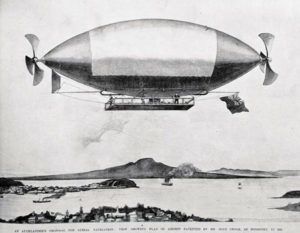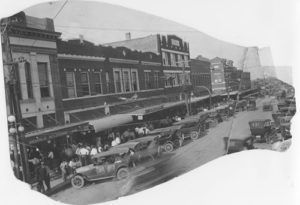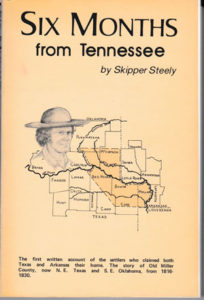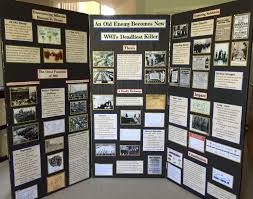
All that remains of the Tidwell community is the Tidwell Baptist Church and Cemetery. The dense thickets were cleared for cotton farming.
Google Maps photo
The United States in the 19th Century did not allow women many rights. They were considered too delicate to handle finances or to manage their own businesses. Economics were too complex for their understanding. It was the duty of fathers, husbands, even brothers to handle such matters for women whose duty it was to raise children and be concerned about her husband. No more and no less.
Since life expectancy was much shorter at that time, it was assumed that a widow would need a strong man to care for her. Men who found themselves widowers felt unable to care for children. Therefore, second, third and even fourth marriages were the norm.
Such is the case of William Etier or “Bill Aikey” as he was known in Hunt County. In June 1874, Bill filed suit for a divorce from Sarah Jane Maxwell Etier, which the judge granted. In his petition we find an amazingly humorous, but probably very true account of the post-Civil War era.
Bill Aikey hired Col. Dan Upthegrove, a young and enterprising attorney in Greenville to represent him in the case. It is from Upthegrove’ petition that we learn the affairs of Bill and Sarah Jane.
Bill began his petition complaining that Sarah Jane Etier, nee Maxwell, should have always retained the surname Maxwell. As the tale unfolds, you may agree.
Bill lost his beloved wife in 1871, leaving him with seven children ages twenty-two to three. In the fall of 1872 Sarah Jane crossed Bill’s way, a widow also with seven children. Bill admitted Sarah had “mighty winning ways.” She was mild mannered and claimed her children were angels. But, she would be the last woman to “wheedle him into matrimony.”
On a Sunday morning in December 1872, (1873 according to marriage records in Hunt County Clerk’s Office) Sarah Jane convinced Bill it was time to go see Preacher Thomas Reedy who united the couple in the bonds of holy matrimony. According to customs of the time, Bill and his kids moved in with Sarah Jane and her seven children. Immediately war broke out. The kids fought, Sarah Jane nagged and hit Bill over the head, and Bill mouthed and cussed. The location of Sarah Jane’s home she inherited from her late husband did not help matters. It was in the absolute middle of Tidwell Thicket where the sun shone about two hours on a good day.
Bill must have been very strong physically. By June 1873 he had cleared all of the trees and brush around the house, plowed and fenced new fields, planted and raised a good crop. At that point Sarah Jane issued an ultimatum to Bill: take your “brats and git up and git.” That’s when Bill went looking for Col. Upthegrove.
The Honorable W. G. Andrews, Judge of the 11th Judicial District of the State of Texas issued the divorce decree in June 8, 1874. One wonders if Sarah Jane wheedled another man to do more work on her farm? What happened to Bill Aikey?
No records were found of either family but the divorce petition can be found in Pace’s Texas Scrap Book: Containing Gems of Thought from Bench, Bar, Pulpit, Rostrum on Religious, Political and Educational Subjects (Dallas 1933). Here is a transcription of the divorce petition:
DIVORCE PETITION
ETIER vs. ETIER
IN THE DISTRICT COURT OF HUNT COUNTY, TEXAS. TO THE HON. W. G. ANDREWS, JUDGE OF THE 11TH JUDICIAL DISTRICT OF THE STATE OF TEXAS:
Your unfortunate petitioner, William Etier, who is generally known as Bill Aikey, and who has been before your honor in time past, and to whom your honor granted a new trial when petitioner believed he was gone where the “Woodbine twineth”, and who is a citizen of Hunt, State aforesaid, complaining of Sarah Jane Etier, who is also a resident citizen of said County and State, and who was formerly, and always should have remained, Sarah Jane Maxwell. Petitioner states that in the year 1871, he lost his beloved wife, leaving him a disconsolate widower with seven children to mourn with him their loss. Petitioner states that the respective names and ages of his children are as follows: William Henry Harrison, my first born, 22 years old; Nap, my second born, 20 years old; Franklin, my third born, 18 years old, Myra, my fourth born, 16 years old; Boston, my fifth born, 7; Nancy, 5; Henry, 3.
In the Fall of 1872, Sarah Jane Maxwell crossed his way, and if your petitioner had followed the advice of Tony Weller to his son, Samuel, this suit would never have been brought. Petitioner would further state that the said Sarah Jane was a woman of mighty winning ways before they were married, and one of the mildest mannered women he ever saw. Petitioner would further state that the said Sarah Jane told him that all of her children were angels, and that she believed petitioner’s children were angels for they looked just like their Dad. Sarah Jane told petitioner that she was raising up her children in the fear and admonition of the Lord, and that she required her children to repeat the Lord’s Prayer every night; all of which petitioner believed, for the said Sarah Jane repeated to the petitioner the said prayer which begins, “Now I lay me down to sleep,” etc. Now right here, let petitioner state that the said Sarah Jane is the last woman that will ever wheedle him into matrimony on the piety side of the docket.
Petitioner would further state that on a Sunday morning in December 1872, the said Sarah Jane came to the house of the petitioner, and by her fascinating walk and pious conversation induced petitioner to go to the house of that Godly man, Thomas Reedy, and there they were united in the holy bonds of matrimony; and your petitioner, believing he had a Dorcas for a wife, thought it was his duty to follow the injunction of the Scriptures, and leave home, father and mother, and cleave unto his wife, so he left his home, taking with him his seven children, and went to the house of the said Sarah Jane, in Tidwell Thicket, and here petitioner would like for a veil of oblivion to fall upon the scene, and what followed to be lost to history and to man, but as the veil of oblivion will not fall, petitioner is bound to tell what happened.
Petitioner soon discovered that when he went into the house of the said Sarah Jane, his Dorcas was gone, and he had a Mary Magdalene with her seven devils – for soon the Maxwells wanted to know if the Aikeys would mix; and it is well known that wen the Aikey blood is up they will not be imposed one – as mix it was. Your petitioner jumped upon the head of a barrel, and, in the language of our President, cried out, “Let us have peace;” but about that time Sarah Jane motioned a stick at petitioner – and here petitioner makes his head “Exhibit A” to show the result of that fight.
Petitioner would further state that in order to have a clear and comprehensive view of the case we must understand the geographical position of the home of said Sarah Jane. Sarah Jane is the middle-man in Tidwell Thicket. Plump in the center of said thicket is where she lives, and to this place petitioner was conducted; and the place was gloomy enough indeed, for the Sun shone only two hours a day, and then was let down by lead troughs; but this darkness would have been sufferable to a newly married man, if it had not continued so long. For three weeks petitioner worked night and day before he saw the Sun. Petitioner believes and thinks that the sequel will show that the said Sarah Jane wheedled him into matrimony for no other purpose than to get him to clear up the thicket, because from the first she was abusive; but at first her abuse was bearable, but just in proportion as petitioner cleared up the thicket she became more abusive, and when petitioner had cleared and fenced a good field, planted and raised a good crop, the said Sarah Jane – putting on a full head of steam – told petitioner to take his Aikey brats and git up and git, and it is needless to tell anyone who knows Sarah Jane that petitioner had it to do.
Petitioner would state that he had always made the said Sarah Jane a good and obedient husband, and did all in his power to make her happy; but for every kind word, an insult would return; and when Sarah Jane was not abusing petitioner, the children were in a row. Petitioner states that since June, 1873, the time when petitioner was driven away by the said Sarah Jane, they have lived separate and apart, having no communication, or association as man and wife. It is true petitioner mentioned several times the subject to the said Sarah Jane, but she replied, “Bill Aikey, you blamed old fool! I have got my land cleared up now; I would not live with you again to save your life.” Petitioner would further state, that he had lived with several wives before, in perfect peace and harmony, for he was always repeating those old and beautiful lines from Ignomar to Parthenia, “Two souls with but a single thought, two hearts that beat as one,” but petitioner states that since he married Sarah Jane, he has not repeated those lines much. And will further say that he believed that matches were made in Heaven until he married Sarah Jane, but that he now doubts that theological dogma.
Petitioner states that the said Sarah Jane kept up a continual clatter about her dear, dear, dead husband, and what he did and could do; and how much better her dead husband was than the petitioner, and that her children were much better than the petitioner’s; and petitioner states that he well knows that for a scientific aggravation Sarah Jane has no equals in these parts. Petitioner is now fully convinced that marriage is nothing but a civil contract, and when broken on the other, and as Sarah Jane drove petitioner away from her home, and refused to live with him or to have anything to do with him, he is certainly entitled to have the contract abrogated.
Wherefore, the petitioner prays and sues, etc.
June 8th, 1874
Signed, DANIEL UPTHEGROVE, Attorney for Plaintiff.
